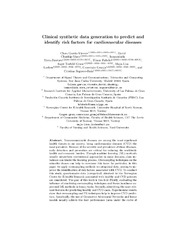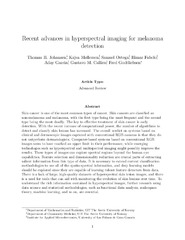Blar i forfatter "Fabelo, Himar"
-
Characterizing the Impact of Physical Activity on Patients with Type 1 Diabetes Using Statistical and Machine Learning Models
Chushig-Muzo, David; Calero-Díaz, Hugo; Fabelo, Himar; Årsand, Eirik; van Dijk, Peter Ruben; Soguero-Ruiz, Cristina (Journal article; Tidsskriftartikkel; Peer reviewed, 2024-10-29)Continuous glucose monitoring (CGM) represents a significant advancement in diabetes management, playing an important role in glycemic control for patients with type 1 diabetes (T1D). Despite their benefits, their performance is affected by numerous factors such as the carbohydrate intake, alcohol consumption, and physical activity (PA). Among these, PA could cause hypoglycemic episodes, which ... -
Clinical Synthetic Data Generation to Predict and Identify Risk Factors for Cardiovascular Diseases
García-Vicente, Clara; Chushig-Muzo, David; Mora-Jimenez, Inmaculada; Fabelo, Himar; Gram, Inger Torhild; Løchen, Maja-Lisa; Granja, Conceição; Soguero-Ruiz, Cristina (Journal article; Tidsskriftartikkel; Peer reviewed, 2023-01-21)Noncommunicable diseases are among the most significant health threats in our society, being cardiovascular diseases (CVD) the most prevalent. Because of the severity and prevalence of these illnesses, early detection and prevention are critical for reducing the worldwide health and economic burden. Though machine learning (ML) methods usually outperform conventional approaches in many domains, class ... -
Early Detection of Change by Applying Scale-Space Methodology to Hyperspectral Images
Uteng, Stig; Johansen, Thomas Haugland; Zaballos, Jose Ignacio; Ortega, Samuel; Holmström, Lasse; Callico, Gustavo M.; Fabelo, Himar; Godtliebsen, Fred (Journal article; Tidsskriftartikkel; Peer reviewed, 2020-03-27)Given an object of interest that evolves in time, one often wants to detect possible changes in its properties. The first changes may be small and occur in different scales and it may be crucial to detect them as early as possible. Examples include identification of potentially malignant changes in skin moles or the gradual onset of food quality deterioration. Statistical scale-space methodologies ... -
Evaluation of Synthetic Categorical Data Generation Techniques for Predicting Cardiovascular Diseases and Post-Hoc Interpretability of the Risk Factors
García-Vicente, Clara; Chushig-Muzo, David; Mora-Jiménez, Inmaculada; Fabelo, Himar; Gram, Inger Torhild; Løchen, Maja-Lisa; Granja, Conceição; Soguero-Ruiz, Cristina (Journal article; Tidsskriftartikkel; Peer reviewed, 2023-03-23)Machine Learning (ML) methods have become important for enhancing the performance of decision-support predictive models. However, class imbalance is one of the main challenges for developing ML models, because it may bias the learning process and the model generalization ability. In this paper, we consider oversampling methods for generating synthetic categorical clinical data aiming to improve the ... -
Histological Hyperspectral Glioblastoma Dataset (HistologyHSI-GB)
Ortega, Samuel; Quintana-Quintana, Laura; Leon, Raquel; Fabelo, Himar; de la Luz Plaza, María; Camacho, Rafael Conde; Callico, Gustavo M. (Journal article; Tidsskriftartikkel; Peer reviewed, 2024-06-24)Hyperspectral (HS) imaging (HSI) technology combines the main features of two existing technologies: imaging and spectroscopy. This allows to analyse simultaneously the morphological and chemical attributes of the objects captured by a HS camera. In recent years, the use of HSI provides valuable insights into the interaction between light and biological tissues, and makes it possible to detect ... -
Recent advances in hyperspectral imaging for melanoma detection
Johansen, Thomas Haugland; Møllersen, Kajsa; Ortega, Samuel; Fabelo, Himar; Garcia, Aday; Callico, Gustavo; Godtliebsen, Fred (Journal article; Tidsskriftartikkel; Peer reviewed, 2019-04-22)Skin cancer is one of the most common types of cancer. Skin cancers are classified as nonmelanoma and melanoma, with the first type being the most frequent and the second type being the most deadly. The key to effective treatment of skin cancer is early detection. With the recent increase of computational power, the number of algorithms to detect and classify skin lesions has increased. The overall ... -
Regulated Power Supply with High Power Factor for Hyperspectral Imaging Applications
Cabrera-Peña, Jose M.; Leon, Raquel; Ortega, Samuel; Fabelo, Himar; Quevedo, Eduardo; Callico, Gustavo M. (Journal article; Tidsskriftartikkel; Peer reviewed, 2025-01-22)Illumination is a crucial factor in hyperspectral imaging systems. In this respect, this work is focused on analyzing the influence of the light power source in acquiring hyperspectral images. To this end, a custom regulated power supply was designed and developed. This power supply was then integrated into a hyperspectral acquisition system, and several light stability measurements were conducted. ... -
Unifying heterogeneous hyperspectral databases for in vivo human brain cancer classification: Towards robust algorithm development
Martín-Pérez, Alberto; Martinez-Vega, Beatriz; Villa, Manuel; Leon, Raquel; Martinez de Ternero, Alejandro; Fabelo, Himar; Ortega, Samuel; Quevedo, Eduardo; Callico, Gustavo M.; Juarez, Eduardo; Sanz, César (Journal article; Tidsskriftartikkel; Peer reviewed, 2025-02-18)Background and objective - Cancer is one of the leading causes of death worldwide, and early and accurate detection is crucial to improve patient outcomes. Differentiating between healthy and diseased brain tissue during surgery is particularly challenging. Hyperspectral imaging, combined with machine and deep learning algorithms, has shown promise for detecting brain cancer in vivo. The present ...


 English
English norsk
norsk






